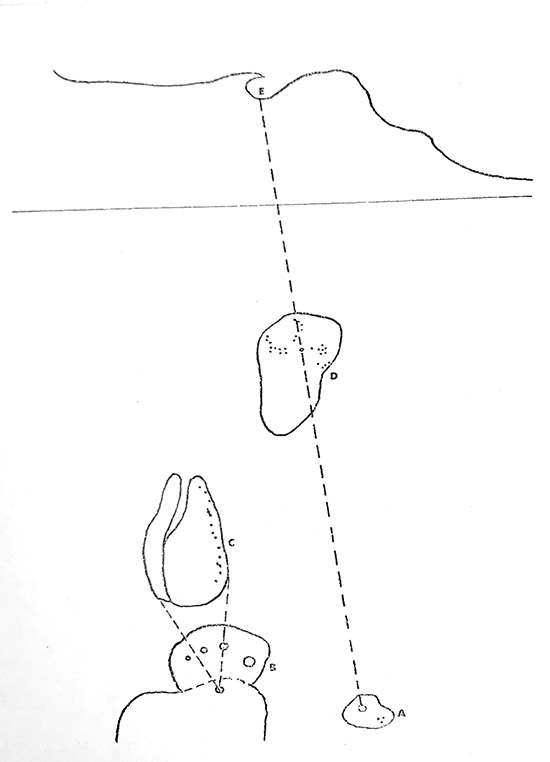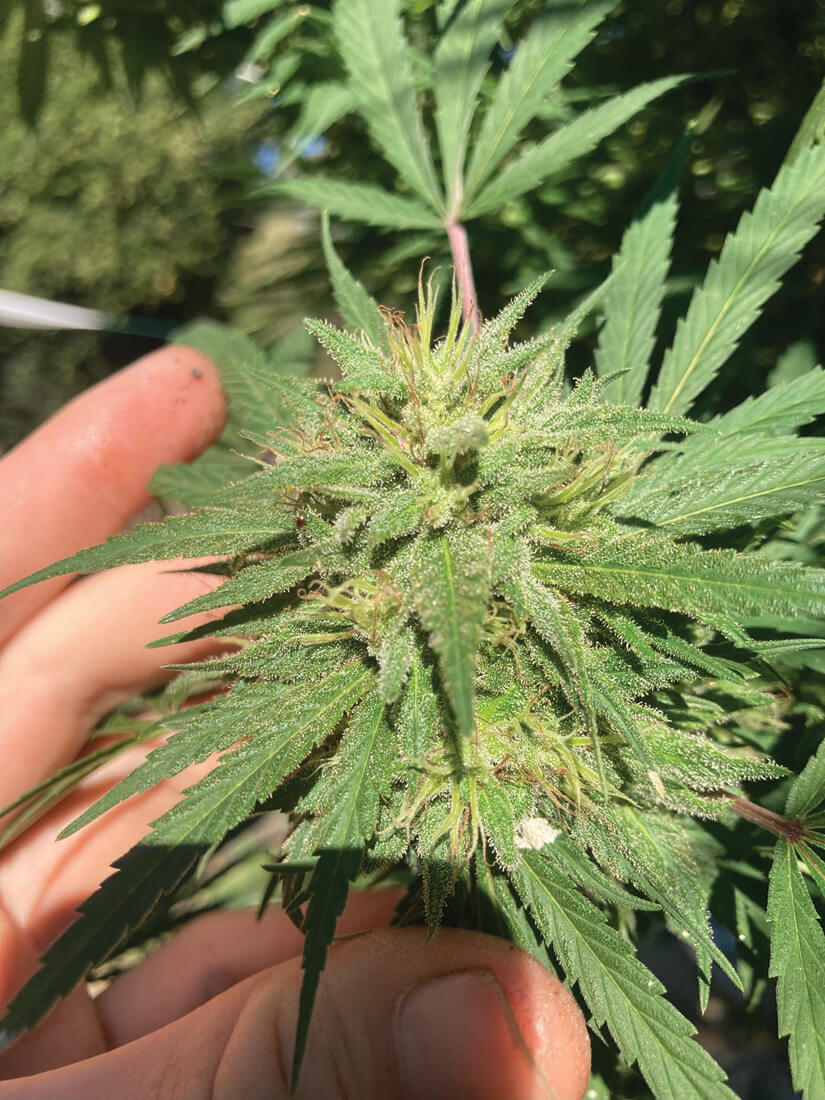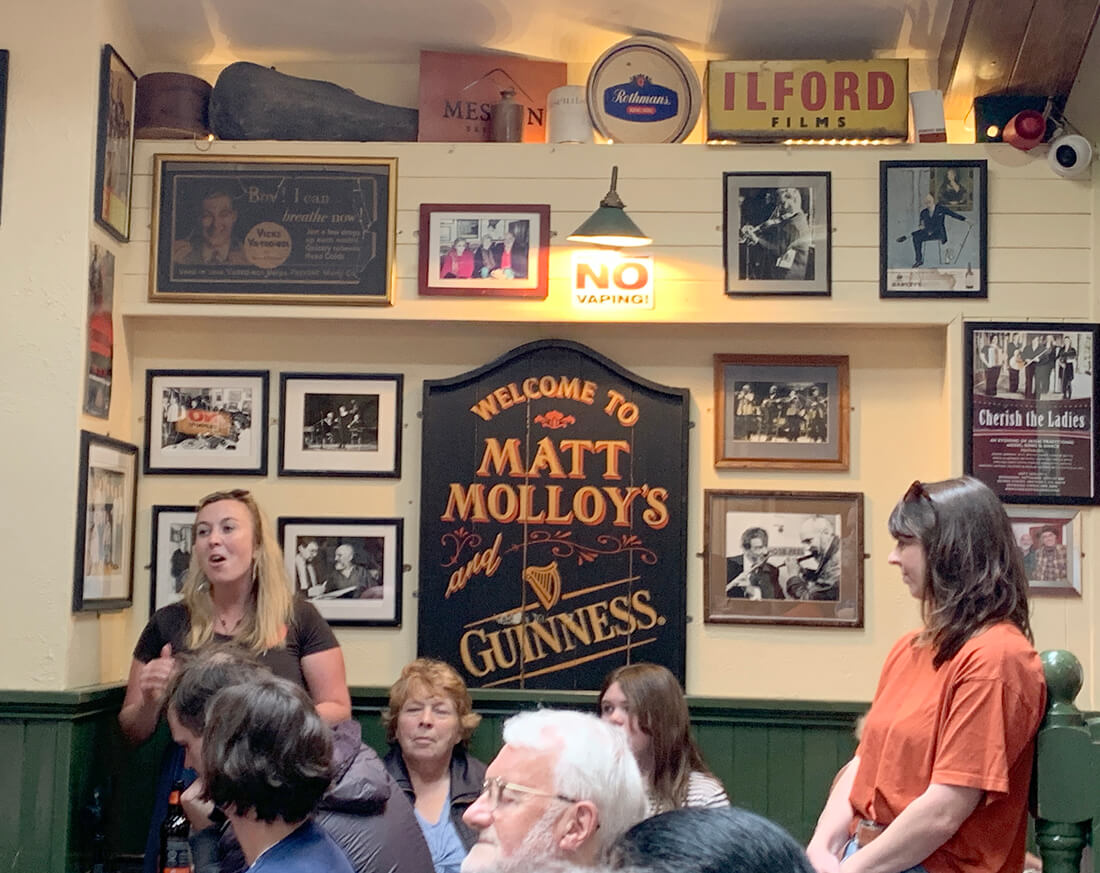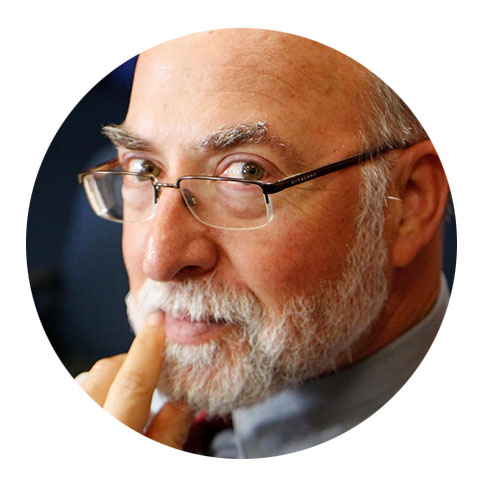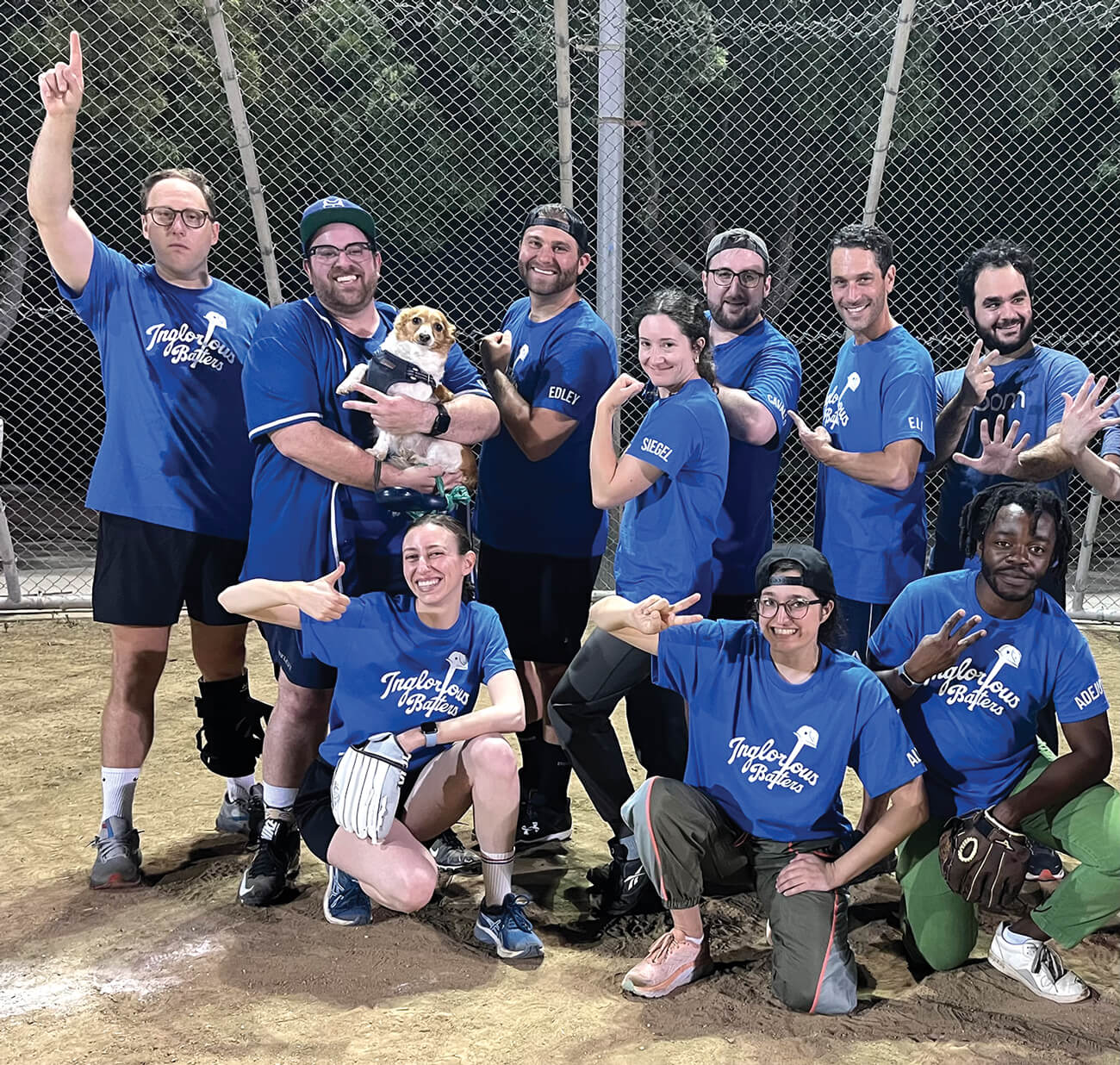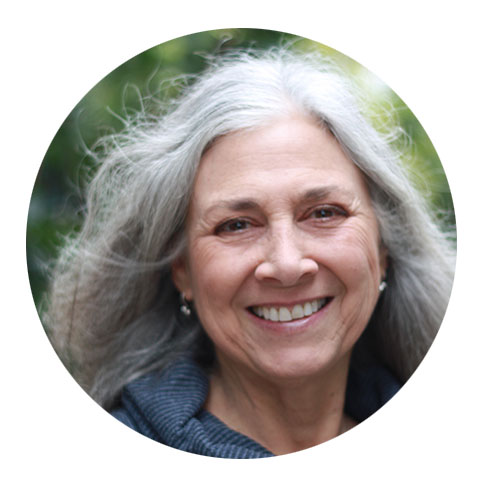A Personal View Of The Ssfl Cleanup, Part 2 | |
A Personal View Of The Ssfl Cleanup, Part 2We left Part 1 of this story at 1983, when the research and monitoring of ancient astronomical signs by intrepid graduate students, Dan Larson, John and Gwen Romani, came to an end for almost 20 years. In 1999, Dr. Edwin C. Krupp, Director of the Griffith Observatory and archaeoastronomer, invited them back for the 20th Anniversary of the Santa Susana Field Lab (SSFL). John Romani passed away in August 2011, and Gwen in 2018. Larson is the sole survivor of the close-knit research team that began in 1977 as graduate students at CSUN.
1979 Research at the Santa Susana Field Laboratory
The summer solstice of the Burro Flats Painted Cave site complex is much more complicated than its winter solstice counterpart (See ŌĆ£A personal view of the Santa Susana Field Laboratory, Part 1,ŌĆØ The Canyon Chronicle, February 19, 2021).
The summer solstice area contains five separate features which include both direct and indirect observation, and at least three elements that need to be precisely placed to create the effects (refer to map): (A) An isolated bedrock mortar (not pictured; (B) The ŌĆ£Bear PawŌĆØ mortar configuration with five bedrock mortars closely spaced but not equidistant from each other that are graduated in size with the westernmost being the smallest, and the largest being the easternmost. The fifth bedrock mortar represents the bearŌĆÖs foot and aligns with second largest toe and is bisected by the shadow dagger; (C) A narrow, oblong, cracked boulder slightly less than five feet tall with a line of 19 cupules parallel to its eastern edge; (D) Large boulder with semi-circle and clusters of cupules (not pictured); (E) Summer solstice sunrise notch (not pictured).
Although we made a trial visit to the Burro Flats site in June 23, 1979, IŌĆÖll focus on our trip in 1980 when we invited Dr. Krupp to join us.
When the monitoring began, I stood directly behind the isolated bedrock mortar feature because I had proposed a hypothesis that in some cases, the isolated bedrock mortars served as fixed-point monitoring stations for Native American observers during winter and summer solstice periods. Two things happened, one direct and one indirect. LEGEND Figure 3. Overall view of Burro Flats summer solstice sunrise area. (A) Isolated bedrock mortar (Not pictured); (B) ŌĆ£Bear PawŌĆØ mortar configuration; (C) Line of cupules; (D) Large cupule boulder; (E) Summer solstice sunrise notch. |
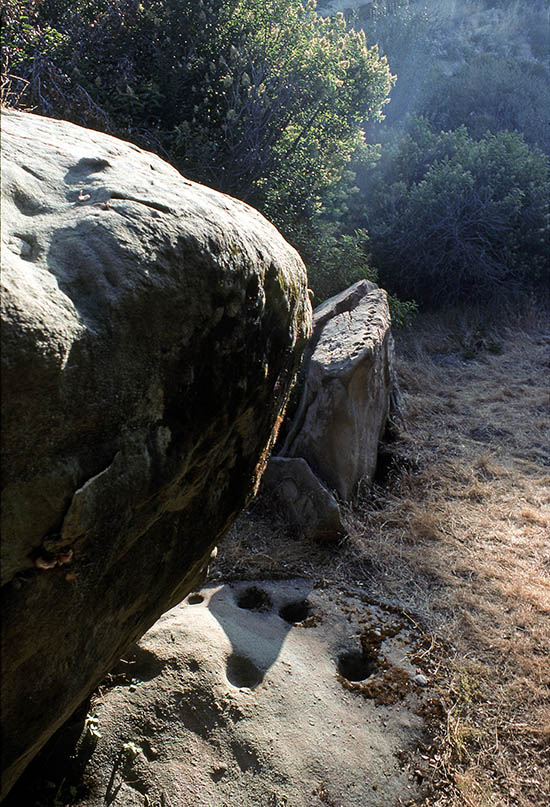 Narrow, oblong, cracked boulder (C) in background throws a ŌĆ£shadow daggerŌĆØ on the isolated bedrock mortar known as the ŌĆ£Bear PawŌĆØ (B). DIRECT: First, from my position, as the sun rose, the first gleam filled the exact center of the lower half of the hooked notch (E) that I had predicted. After seeing the first centered gleam, I took a full step to the east side of the bedrock mortar (A) and found that the gleam was visibly off-center; then to the west side where the gleam was also equally off-center.
INDIRECT: In addition, the largest cupule in the boulder (C) seemed to be visually aligned with the center of the hook-shaped notch. This could be interpreted as an indirect alignment since the ŌĆ£near horizonŌĆØ notch is located high above the cupule itself.
The bear paw feature (B) also represents an indirect alignment. As the sun rose in the hook-shaped notch, a shadow fell along the eastern edge of the boulder (C)and fell in a straight line along the eastern edge, exactly bisecting the second toe of the bedrock mortar from the east.
At the time, neither Dr. Krupp nor we knew the exact meaning of the summer solstice area at the Burro Flats site complex. However, the fact that five elements in the five features were precisely placed to make direct, as well as indirect alignments occur, indicated that the summer solstice sunrise was important in this area.
While I felt the isolated bedrock mortar was a fixed-point monitoring station, Dr. Krupp felt that the horizon was simply too close to be accurate enough. I also suggested that a straight pole may have been placed upright in the largest cupule and held steady by a separate individual to compensate for the visual elevation difference. Dr. Krupp found this argument to be interesting but not compelling.
Everyone found the exact bisection of light and shadow of the toe bedrock mortar to be very intriguing, but no one knew why.
Dr. Krupp began research on Chumash astronomy in the late 1970s and found a good amount of ethnographic and ethno-historic information from notes taken by anthropologist J. P. Harrington from interviews with Ventureno Chumash, Fernando Librado, during the first 15 years of the 1900s.
Librado stated that the month of June, the month of the summer solstice, was ŌĆ£when things are divided in half.ŌĆØ While doing research in California Native astronomy, starting in 1986, Dr. Krupp was directed to a rock shelter located on what is known as Mutau Flat in the Los Padres National Forest in the southern Sierra Madre, Ventura County.
Inside the shelter is a broken dish-shaped feature which is bisected when light enters. This second instance certainly strengthens the argument that bisected (half shadow and half light) bowl-shaped features occurring during the summer solstice period are meaningful, since these features had to be precisely placed to receive light (Mutau Flat Rockshelter) or shadow (Burro flats summer solstice area).
Dr. Krupp was quite intrigued but felt it was not provable since there is no information on such opposition within the Chumash. While the light effect of the winter solstice requires only one monitor, the summer solstice effects need a minimum of two monitors to successfully observe the effects. The space around the Burro Flats Painted Cave, where the winter solstice occurs, is quite confined with maybe enough room for 15 people, while the summer solstice area is relatively open, with room for dozens of people, i.e., a better place for large gatherings.
One last thing about the summer solstice area is when Dr. Krupp was invited to view the summer solstice sunrise by the local Fernandeno Chumash group in 2018, the bisected bedrock mortar alignment no longer occurred. The bedrock mortar was almost entirely in shadow, meaning the portion of the narrow cracked boulder that has the line of 19 cupules is leaning more to the east. Dr. Krupp believes that the movement may have occurred as a result of the 2005 fire that directly affected the area. His last visit for a summer solstice sunrise had been in 2002.
We can only hope that NASA, with extensive input from the involved Native American groups, will take on the responsibility to stabilize the boulder so that the original alignment is restored and the originally intended alignment can be part of the Chumash summer solstice ritual again.  | 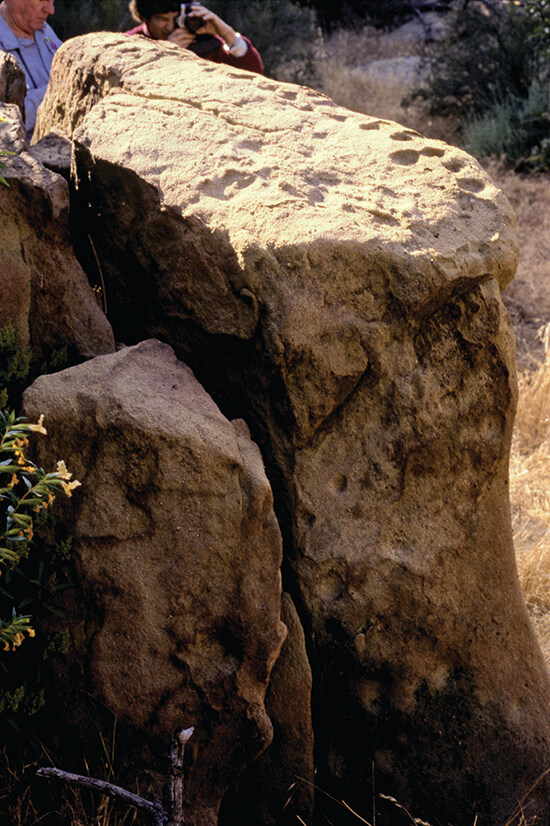 Closeup of narrow, oblong cracked boulder with 19 cupules 1983 at the SSFL
There were two events leading up to 1983, one which I had no idea of the importance of at the time, and one that abruptly ended our field involvement at the SSFL for twenty years.
Beginning with our first visit to the SSFL, our guide was Fred Couture, Fire Protection Engineer for the Rocketdyne Division of Rockwell International, which owned all the SSFL property bought by Boeing in 1996. Aside from being our guide, he became a friend and enthusiastically supported our work.
We became such quick friends that Fred invited John and Gwen Romani and me to his condo and introduced us to his wife. He became so interested in the local Chumash culture that when a new branch of the bank in which he had an account, opened in the Westlake Village area, he asked us to set up an exhibit as an attraction for the opening. We had a great time and kept the various sections of the exhibit that we used in later years.
One day, while Gwen and I were doing research at the village midden portion of the Burro Flats Painted Cave site complex, we felt the ground rumble and heard a giant blast. We immediately turned to Fred and he said something like, ŌĆ£Oh yeah, theyŌĆÖre testing the Space Shuttle Engine today.ŌĆØ We never saw any smoke or fire from the test even though it was just over a high ridge in front of us. The way he spoke seemed to indicate this was not an unusual occurrence.
When this happened, we had just finished eating our lunch. Gwen and I had just picked up the blanket to take it to her truck when we suddenly felt a liquid spray falling on us. Fred, who was standing next to us said, ŌĆ£WeŌĆÖd better get to our vehicles,ŌĆØ which we immediately did. Interestingly, none of our group ever witnessed any engine test of any kindŌĆösuch as test firings of rocket stage engines, as well as components such as the Space Shuttle Main Engine (SSME)ŌĆöwhile doing our research at the complex, except for that one seemingly innocuous day.
When Gwen and I asked about the incident in 2016, officials from both the Department of Energy (DOE) and Boeing told us not to worry since it was clean water we felt. To this day, I feel this explanation might be faulty since I canŌĆÖt imagine that power-sprayed water wouldnŌĆÖt have contained at least some diluted TCE, since the chemical would have been thoroughly ingrained in the test stands from being used so often. Gwen passed away in 2018. I am now the sole survivor who witnessed a space shuttle rocket test, while doing research on a Chumash astronomical site.
That was our last visit to the SSFL, until Dr. Krupp invited us back in 1999 for the SSFL 20th anniversary.  | 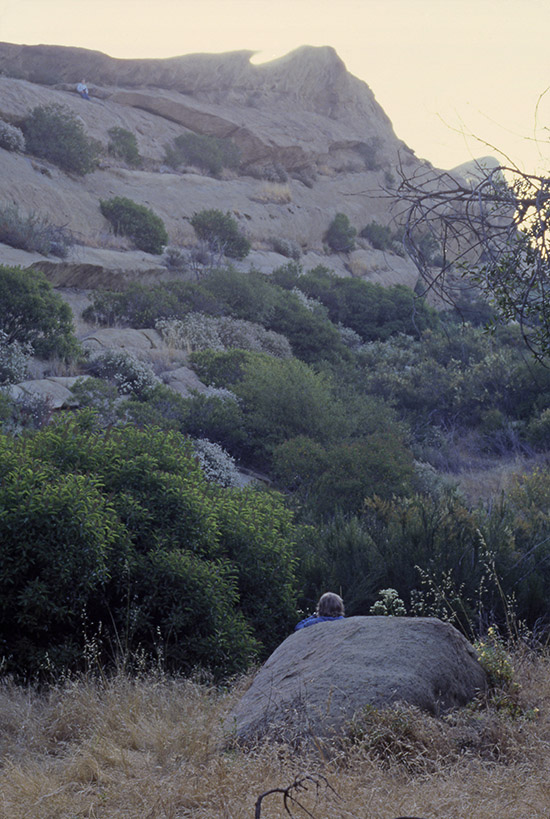 (E) View of hooked sunrise notch at top of mountain with (D) large boulder in foreground. EPILOGUE: 2021 Summer Solstice and the SSFL
Dan Larson started researching information on rocket engine testing in NASA ŌĆśs Area II when the official environmental review came out in 2012 and lhe earned that when test firing engines such as the SSME, a chemical, Trichloroetholyene (TCE), was used to clean the test stands before and after each test. After the TCE dried, the stand was sprayed with clean water which was probably the wet spray we felt that day. TCE has since been identified as a cancer-causing chemical.
Beyond that, Larson is concerned and currently working on preservation of the remaining Bravo and Coca rocket test stand areas at the NASA-administered land at the SSFL. They are scheduled to be demolished this year, imminently, and he has been appealing the decision to NASA and other officials, namely Grant Cope of the Department of Toxic Substance Control (DTSC), the lead agency overseeing the cleanup of the entire SSFL. DTSC is also responsible for following the guidelines of the 1970 California Environmental Quality Act (CEQA) with regard to cultural, biological, and natural resources as a State agency.
In defense of preserving the test stands as a historical site, Dr. Krupp wrote in a 2014 letter to NASA, ŌĆ£The NASA test stands and the Burro Flats painted shelter comprise the only place on earth where our modern world heritage in space converges with the prehistoric reach for the skyŌĆ”. For that reason, the place is irreplaceably significant in the history of space exploration, the history of NASA, the history of California and America, and the history of the world.ŌĆØ  | | | | | | | | | | | | |
|
|
|
|
|




